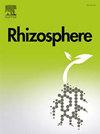Development of whole-soil microbial inoculants based on solid-phase fermentation for the regeneration of the functioning of vineyard soils
IF 3.4
3区 生物学
Q1 PLANT SCIENCES
引用次数: 0
Abstract
Achieving the sustainability of modern agriculture will require, among other actions, an improvement of the soil and its associated microbiota. One way to achieve this is through the inoculation with beneficial soil microbial communities. In this study, we used solid-phase fermentations to produce 25 distinct microbial inoculants based on complex communities obtained from the rhizosphere of 23 European vineyards. For this purpose, we mixed 0.1 g of donor rhizosphere soil and 25 g of ground and sterilized growing substrate composed of winemaking byproducts in 15-cm Petri dishes. Aerobic fermentations were carried out for a period of 56 days and the activity of microbial enzymes linked to the biogeochemical cycling of carbon, nitrogen, phosphorus, and sulfur was evaluated every two weeks. We then carried out a common garden experiment where the inoculants were tested in pots containing vineyard soil and planted with Tempranillo vines. During the fermentation, the enzyme activity of the inoculants evolved from no activity to high-activity values. Carbon- and phosphorus-linked enzymes tended to show higher activity after 14 days of incubation and then decreased or remained constant, while nitrogen-linked enzymes tended to show their highest values after 28 days of incubation. Despite these general patterns, inoculants developed from different rhizosphere communities followed different trajectories in terms of activity. In addition, we observed significant relationships between the enzyme activity of donor rhizosphere soils and the enzyme activity of inoculants, especially after 28 days of incubation. We also found a significant relationship between the enzyme activity of the inoculants and the enzyme activity measured in the soil of pots containing vines. Our results suggest the possibility of predicting the metabolic potential of the inoculants from the metabolic potential of their donor soil sample, as well as the possibility of transferring these metabolic capabilities to soils, with likely applications for the regeneration of the functioning of vineyards.

求助全文
约1分钟内获得全文
求助全文
来源期刊

Rhizosphere
Agricultural and Biological Sciences-Agronomy and Crop Science
CiteScore
5.70
自引率
8.10%
发文量
155
审稿时长
29 days
期刊介绍:
Rhizosphere aims to advance the frontier of our understanding of plant-soil interactions. Rhizosphere is a multidisciplinary journal that publishes research on the interactions between plant roots, soil organisms, nutrients, and water. Except carbon fixation by photosynthesis, plants obtain all other elements primarily from soil through roots.
We are beginning to understand how communications at the rhizosphere, with soil organisms and other plant species, affect root exudates and nutrient uptake. This rapidly evolving subject utilizes molecular biology and genomic tools, food web or community structure manipulations, high performance liquid chromatography, isotopic analysis, diverse spectroscopic analytics, tomography and other microscopy, complex statistical and modeling tools.
 求助内容:
求助内容: 应助结果提醒方式:
应助结果提醒方式:


